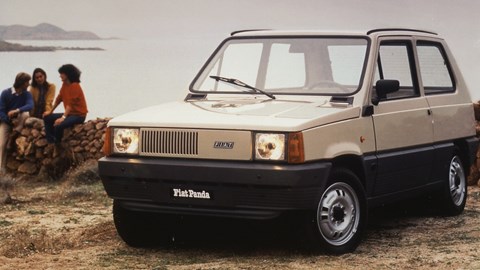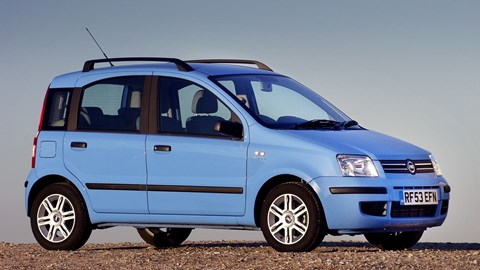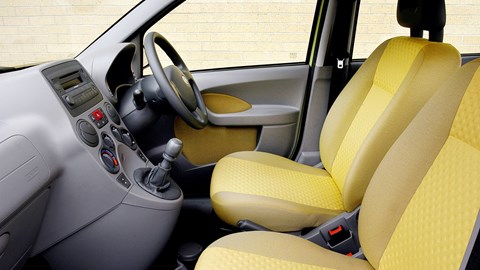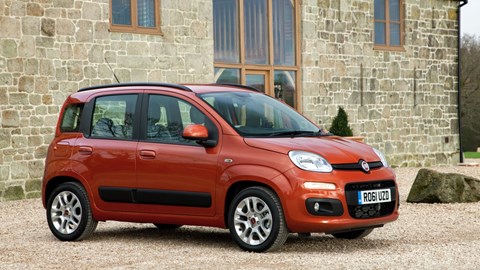► Panda celebrates 40 years on sale
► Only three generations produced
► Over 280,000 sold in the UK alone
Head into any part of Italy, whether the most rural village or the middle of Milan, and you’ll find the streets overrun by wildlife of a most particular, boxy kind. The Panda was Fiat’s answer to cars like the Renault 4 and Citroen 2CV – staunchly utilitarian transport for the masses, meant to accommodate five passengers and luggage in a practical hatchback body, with economy of repair and operation at the forefront.
That the original was designed by the brilliant Giugiaro of then newly-formed Italdesign can’t have hurt sales, and the result is a car that, like the original Mini, transcends snobbism and social class to gain favour with an entire nation.
Launched to the press in 1979 and the public in 1980, the Panda’s mere three generations speak volumes about its popularity – consider the eight-plus generations of Volkswagen Golf released with only six additional years under its belt. And the current car, though it’s getting on for a decade old, remains the bestselling model in Italy.
The Panda even has quite a following in the UK, having sold 284,000 examples since launch across its three variations. The latest model – the Hybrid – is the newest and possibly the best Panda yet, but it’d be a stretch to call it the most interesting. Here’s a quick look back at three generations (and numerous special editions) of Italy’s favourite small car.
Panda I – 1981-1995 (UK)
The first Panda mixed the conventional and the clever together with spectacular ease. In many ways, this front-engined, front-wheel drive hatchback was an entirely normal package, despite being a departure from Fiat’s other small cars – the rear-engined, rear-drive 500 and 126. In others, its boxy styling, utilitarian dashboard, hammock-like seats and almost aggressive simplicity were new and exciting.

Originally intended to be called Rustica, the Panda name was brought in at the last minute in honour of Empanda, the Roman goddess of travellers. So no, the lack of resemblance to a fluffy black-and-white bear isn’t just a charming quirk.
Originally supplied with a sole four-cylinder, 903cc petrol engine and just one standard trim level, the Panda’s range would expand as the years advanced. Special editions included the Panda Habitat, a partnership with the furniture chain, and the spectacular Panda Italia 90 – a celebration of Italy’s hosting of the 1990 FIFA World Cup with football-style wheel trims and the cup’s mascot embroidered on the seats.

A five-speed ‘box came around in 1983, while a facelift in 1986 brought a new grille and updated engines.
One trim level that would prove to be enduring was the 4×4. A combination of a flyweight body and Steyr-Puch four-wheel drive system made the Panda 4×4 amazingly capable and it found favour as much among farmers as it did those who just found it cute.
In 1995, after 14 years on sale in the UK and more than 160,000 sales, this Panda was discontinued, but other markets kept hold of it until 2003 when its replacement arrived.
Panda II (2004-2012)
The second-generation Panda commenced UK sales in January 2004. Unmistakably descended from its boxy sibling, it continued that car’s legacy of practicality, simplicity and manoeuvrability. In development, it was known as the ‘Gingo’ – though a tough stance from Renault on the similarities to its existing Twingo soon put paid to that and the Panda name was reborn.

At the time, it rivalled mini cars such as the Daewoo Matiz, Vauxhall Agila and Ford Ka – so it’s no surprise that both press and the public loved the chunky, funky Panda. It won the European Car of the Year award in 2004.
At launch in the UK buyers could choose from 1.1-litre and 1.2-litre engines, in trims ranging from barebones Active to classy Eleganza. It took until 2005 for the range to grow, including a diesel – Fiat’s 1.3-litre Multijet – and a new Panda 4×4.
2006 saw the introduction of the first sporting Panda – the brilliant 100HP. With a unique bodykit, 15-inch alloy wheels and extended wheelarches, it looked surprisingly potent, and with a sweet-revving 1.4-litre engine producing 99bhp it went like the clappers for such a dinky car.

Special editions in this generation were less brazen than its predecessor but certain examples remain unmistakeble, such as the two-tone Alessi or plastic-clad Cross.
The Panda Mk2 remained on sale until 2012, when the Mk3 we know and love today made its debut.
Panda III (2012 – present)
Still riding on an updated version of its predecessors platform (shared with the Fiat 500, Lancia Ypsilon and indeed the Mk2 Ford Ka) this Panda kept the tall silhouette of the second-generation model but rounded off every corner and added a healthy dose of funk into the styling.

Both inside and out the Panda is dominated by the square-circle hybrid known as a squircle – extending everywhere from the foglights to the instrument cluster and air-conditioning controls.
A 1.2-litre petrol and 1.3-litre diesel engine were carried over but newly inherited from the 500 the Panda also gained a twin-cylinder ‘TwinAir’ petrol. Trim levels were also renamed Pop, Easy and Lounge.
A year later, the 4×4 made its triumphant return, and a year after that was joined by the rugged Panda Cross – the Panda 4×4 on steroids. This tiny bruiser had beefy skidplates, hill-descent control and real off-road driving modes, plus a six-speed gearbox with crawler first gear.
All this gear would soon be applied to a two-wheel drive model, the Panda City Cross. Other special editions include the Panda Waze, launched in conjunction with the navigation app, the Panda Antarctica 4×4 with white paint and penguin graphics, and the classy Panda Trussardi.

The latest model is the Panda Hybrid – with a mild-hybrid system pairing a three-cylinder petrol engine with belt-integrated starter-generator for low emissions and high fuel economy.
The future of the Panda…?
The Panda’s still around for now, and still staunchly combustion-powered – but its spiritual successor may already be in the pipeline. The Centoventi concept was unveiled at the 2019 Geneva motor show and, though it wasn’t named as such, a small plush panda tucked into the modular dashboard storage left no doubt as to its lineage.

The Centoventi is an all-electric city car, with swappable battery packs capable of achieving up to 310 miles of range.
Fiat Centoventi concept: is this the next Panda?
Though it remains a concept, serious interest in the Centoventi from potential customers could fast-track it to production. Regardless, with production of the current Panda still going strong at Fiat’s facility in Italy, the iconic city car’s going to be with us for a while yet.